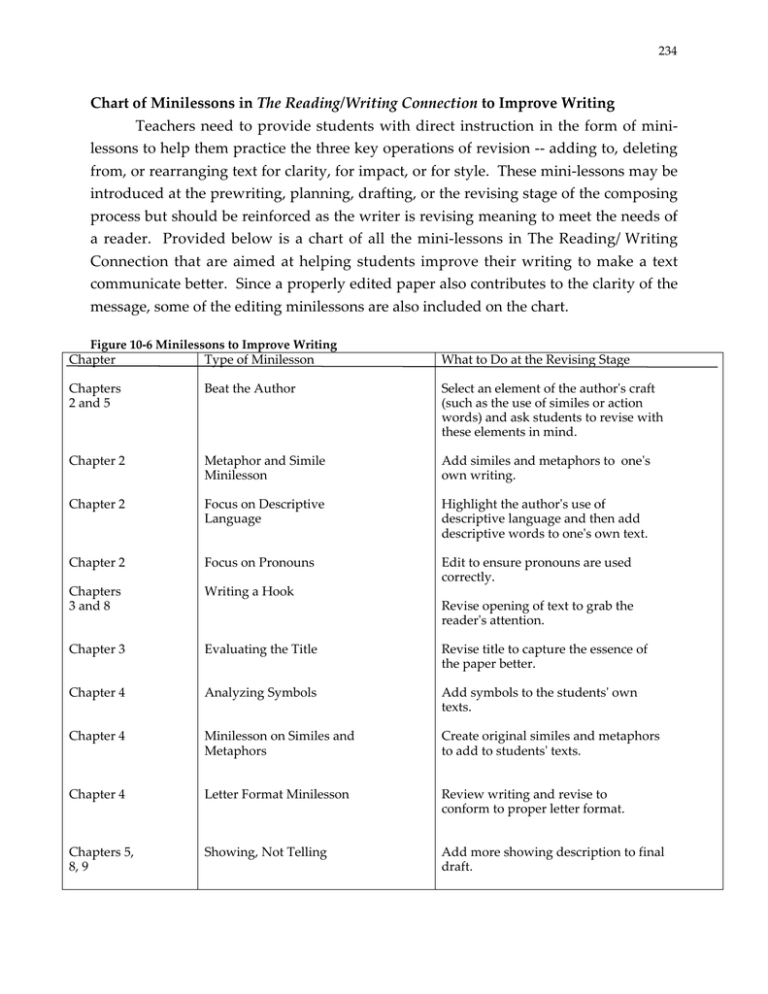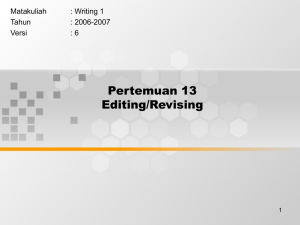Chart of Minilessons in The Reading/Writing Connection to Improve
advertisement

234 Chart of Minilessons in The Reading/Writing Connection to Improve Writing Teachers need to provide students with direct instruction in the form of minilessons to help them practice the three key operations of revision -- adding to, deleting from, or rearranging text for clarity, for impact, or for style. These mini-lessons may be introduced at the prewriting, planning, drafting, or the revising stage of the composing process but should be reinforced as the writer is revising meaning to meet the needs of a reader. Provided below is a chart of all the mini-lessons in The Reading/Writing Connection that are aimed at helping students improve their writing to make a text communicate better. Since a properly edited paper also contributes to the clarity of the message, some of the editing minilessons are also included on the chart. Figure 10-6 Minilessons to Improve Writing Chapter Type of Minilesson What to Do at the Revising Stage Chapters 2 and 5 Beat the Author Select an element of the author's craft (such as the use of similes or action words) and ask students to revise with these elements in mind. Chapter 2 Metaphor and Simile Minilesson Add similes and metaphors to one's own writing. Chapter 2 Focus on Descriptive Language Highlight the author's use of descriptive language and then add descriptive words to one's own text. Chapter 2 Focus on Pronouns Edit to ensure pronouns are used correctly. Chapters 3 and 8 Writing a Hook Chapter 3 Evaluating the Title Revise title to capture the essence of the paper better. Chapter 4 Analyzing Symbols Add symbols to the students' own texts. Chapter 4 Minilesson on Similes and Metaphors Create original similes and metaphors to add to students' texts. Chapter 4 Letter Format Minilesson Review writing and revise to conform to proper letter format. Chapters 5, 8, 9 Showing, Not Telling Add more showing description to final draft. Revise opening of text to grab the reader's attention. 235 Chapter Type of Minilesson What to Do at the Revising Stage Chapters 6 and 7 Quoting From the Text Insert appropriate quotes into the text using proper form. Chapters 6, 7 and 8 The Microtheme If students do not formulate a writing plan prior to the rough draft, they may restructure their essay at the revising stage using the microtheme. Chapter 8 Seashells and Similes Add comparisons to descriptive writing. Chapter 8 Snapshots and Thoughtshots Find places in a rough draft to zero in and write from a telescopic point of view as well as to reveal thoughts and feelings. Chapters 8 and 9 Reviewing Dialogue Revise text to add dialogue. Edit for proper dialogue form. Chapter 8 Transition Words Review text to add smoother transitions. Chapter 8 Thesis Identify and strengthen the thesis. Chapter 8 Color-coding for Commentary Color-code text and revise to add more commentary and supporting detail. Focus on Verb Tenses Chapter 9 Chapters 9 and 10 Edit to make verb tenses consistent. WIRMI (What I Really Mean Is) Revise to communicate one's intended message better. Believing and Doubting Chapter 10 Revise and support assertions. Chapter 10 Sentence Combining Combine sentences for syntactic fluency. Chapter 10 Copy-change Imitate author's style to enhance one's own style. Chapter 10 “There Was a Child Went Forth” Revision Frame Guide Imitate Walt Whitman’s style to create one’s own poem. Chapter 11 Graphic Grammar Learn grammar spatially. Chapter 11 Cloudy With a Chance of Meatballs (Companion Website) Focus on parts of speech and strong verbs. Chapter 11 Animalia (Companion Website) Chapter 11 Type of Minilesson Focus on parts of speech and alliteration. What to Do at the Revising Stage 236 Chapter Type of Minilesson What to Do at the Revising Stage Chapter 11 Adjective Picture (Companion Website) Generate interesting adjectives. Chapter 11 MADDOG (Companion Website) Create a dominant impression with precise nouns. Chapter 11 The Dada Poem Internalize parts of speech and analyze one's own style through color-coding. Chapter 11 Sentence Expanding Expand subjects and predicates for more specific details in writing. Chapter 11 Sentence Unscrambling Practice reassembling sentences to develop syntactic fluency. Chapter 11 Sentence Combining Combine sentences to eliminate errors. Chapter 11 Human Sentences Create kinesthetic sentences to develop syntactic fluency. Chapter 11 Sentence Sorting Sort sentences to develop sentence sense. Chapter 11 Participle Pantomine Practice using participles participial phrases in sentences. Chapter 11 Punctuation Mythology (Companion Website) Create a story to internalize punctuation rules Chapter 11 Vocabutoons Create memory links to expand vocabulary. Chapter 11 Vocabulary Story Collaboarate on a group story to internalize vocabulary. Chapter 11 Word Tree Develop word trees to understand the spelling-meaning relationship. Chapter 11 Word Sorting Construct hypotheses about spelling rules through sorting activity. Chapter 11 Yes Twice, Comma Splice Detect and correct comma splices. Chapter 11 Sentence Draft Detect sentence errors by reading papers backwards, sentence by sentence. and
